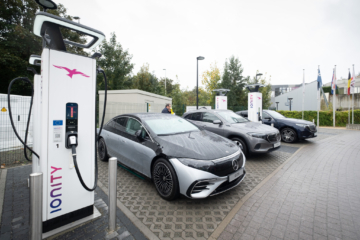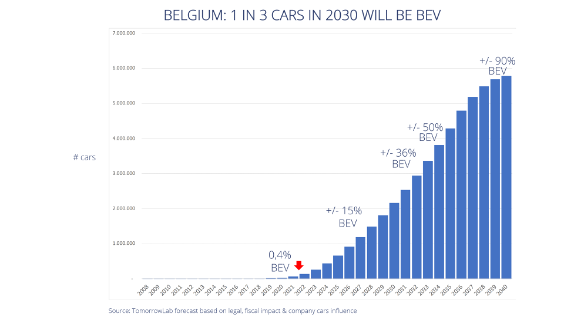What is needed for successful EV-driving at scale?

Smart Mobility envisions transportation and travel for all in a sustainable, safe and efficient way. It requires flawless collaboration between lots of players and many pieces of the puzzle. Today, electrification is one of the major driving forces accelerating a shift to Smart Mobility. What do we need to reach our goals? What parties are or should be involved? And what challenges and opportunities lie ahead? In a series of blogs, we aim to help companies, cities and organisations to map out the road to the mobility of tomorrow.
Smart Mobility envisions transportation and travel for all in a sustainable, safe and efficient way. It requires flawless collaboration between lots of players and many pieces of the puzzle. Today, electrification is one of the major driving forces accelerating a shift to Smart Mobility. What do we need to reach our goals? What parties are or should be involved? And what challenges and opportunities lie ahead? In a series of blogs, we aim to help companies, cities and organisations to map out the road to the mobility of tomorrow.
Smart Mobility envisions transportation and travel for all in a sustainable, safe and efficient way. It requires flawless collaboration between lots of players and many pieces of the puzzle. Today, electrification is one of the major driving forces accelerating a shift to Smart Mobility. What do we need to reach our goals? What parties are or should be involved? And what challenges and opportunities lie ahead? In a series of blogs, we aim to help companies, cities and organisations to map out the road to the mobility of tomorrow.
Smart Mobility is said to be on the eve of its breakthrough, offering many business opportunities for a wide range of sectors and industries. But for Smart Mobility to really take root, innovative products and services, new technology and infrastructure, and changing human behaviour have to reinforce each other. Let’s begin by taking a look at the current situation of one of the driving forces: electrification.
The electric drive
The overall EV market is expanding significantly, also in Belgium. We are at the start of an exponential momentum of a so-called S-curve of adoption in innovation. The figure below shows our expectations for the number of BEVs (Battery Electric Vehicles) in Belgium based on legal, fiscal impact, and company cars influence. We expect 30% of all cars in Belgium will be BEV by 2030. We also expect that the adoption of BEV in new car sales will jump to 66% in 2030 and approximately 90% in 2035. We did not take into account potential effects of (autonomous) car sharing on the total number of cars.

Technology, business model and policy actions will determine the speed and ultimate height of this curve. What reasons are present for a faster and more wide-spread adoption? There is a fading range anxiety as manufacturers compete fiercely in range and performance while introducing masses of new BEV models. When battery costs are dropping, the Total Cost of Ownership for leasing companies and fleet or private owners will be reduced. Hybrid vehicles as an interim solution will peak by 2030 at the latest. Continued and consistent positive fiscal treatment of company cars towards BEV also stimulates adoption. That would turn this infamous and historic ‘system development’ into a huge advantage for faster EV market scaling.
The adoption accelerator point is expected to be around 2023. In terms of policy and business strategy decision making, that means yesterday. So time to speed up.
E-mobility: implications and opportunities
Why should we speed up? Because Electric Vehicles (full EV) are just one part of the picture. E-Mobility requires above all smart energy supply. This is where huge opportunities arise for innovative partnerships. This is already happening. For example, gas stations owners who, in order to stay relevant and future proof, are rethinking their role as mobility energy service provider. Or leasing companies who are integrating the installation of charging infrastructure in their offering. All of this is leading to a new dynamic, in which many partners will have to collaborate: energy providers, grid infrastructure, cities and urban planners, manufacturers, app developers, etc.
But what are the most urgent challenges at hand and how do we deal with them?
Smart charging goes beyond just fast charging. It means that cars are able to support the grid by injecting power, helping to guarantee grid stability and to distribute power more efficiently. Of course, this information must be transparent and readily available so that we can adapt the charging speed and process to make the best possible use of grid capacity. All this while making sure EV drivers can trust to reach their individual destinations timely. The overall idea is to make charging extremely simple and transparent for users, who will only switch to EV if range and charging are guaranteed, and the cost and revenue model is interesting enough.
Role of authorities: facilitating positive change
A significant increase in public charging points will be required to give users range confidence to support the EV uptake. EV charging is currently dominated by home charging, but authorities and private developers are increasing their public charging efforts. Fast public charging is needed at important mobility hubs and across vital road networks. Slower public chargers are typically more relevant for long-parking users; often people without private parking spot or access to a home charger. It is essential to realize an energy infrastructure upgrade, combined with cities and municipalities rethinking how to use the much coveted development space with regard to charging points in the public domain, car parks, idle time and sharing.
The implications for Belgium are real. We have to trigger various mobility policy levels (Federal, regional, local and the newly formed mobility regions) to facilitate this evolution. Obviously, as a small transit country, we cannot – must not – fall behind. Installing a sufficient number of charging equivalents (30.000 is the goal of the incumbent Minister in Flanders) will require multifaced public-private-partnerships with future-oriented corporates, start-ups and scale-ups. They will be developing the technology and appropriate business models to integrate all relevant partners in the entire customer journey, even making decisions for the consumer. Smart? You bet.
Want to build Smart Mobility and shape the future together with us?
Become one of our partners for the brand new innovation campus, a key mobility hub in the Brussels Region.
Latest insights & stories

A Global Movement: The World Unites in a Pink Pledge for Clean and Sustainable Water
5,000 participants. 32 countries. €30,000 funds raised. And that's just the beginning.
Picture this: One step that sends ripples across the globe, transforming lives and creating waves of change. You might wonder, how can such a simple action for most of us have such a profound impact?

Sustainability and circularity in construction
Join us in transforming the future of construction, creating buildings that not only stand the test of time but also contribute to a healthier planet!

RainTunes: Shower scenarios for the soul
Light, hearing, smell, and touch: Together with experts, we have developed sensuous scenarios that turn showering into an individual experience. Whether you want to prepare for the day ahead or relax after working out. Whether you want to refresh after a day’s work or unwind at the end of the evening: RainTunes surprises with multisensory experiences.*
*Currently available only in Germany and Austria.